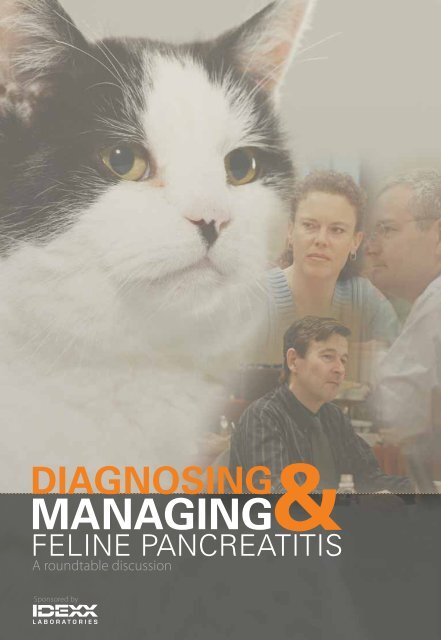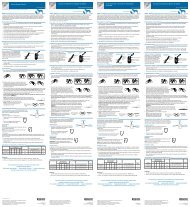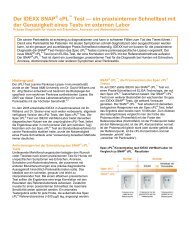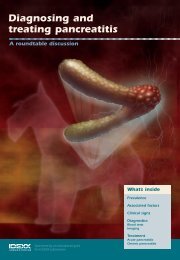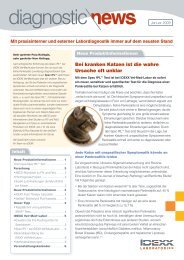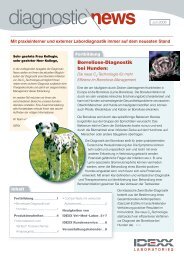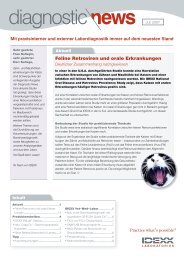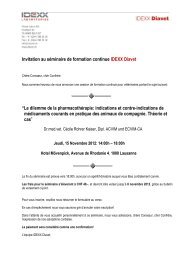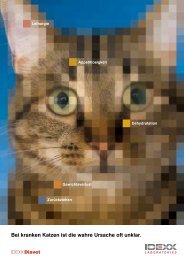Feline Pancreatits - Roundtable discussion - IDEXX Laboratories
Feline Pancreatits - Roundtable discussion - IDEXX Laboratories
Feline Pancreatits - Roundtable discussion - IDEXX Laboratories
You also want an ePaper? Increase the reach of your titles
YUMPU automatically turns print PDFs into web optimized ePapers that Google loves.
DIAGNOSINGMANAGING&FELINE PANCREATITISA roundtable <strong>discussion</strong>Sponsored by
DIAGNOSINGMANAGING&FELINE PANCREATITISA roundtable <strong>discussion</strong>ModeratorJane Robertson, DVM, DACVIM<strong>IDEXX</strong> Reference <strong>Laboratories</strong>West Sacremento, Calif.ParticipantsMarnin Forman, DVM, DACVIMMedVet, Medical Center for PetsWorthington, OhioJörg Steiner, MED. VET., DR. MED.VET., PhD, DACVIM, DECVIM-CATexas A&M UniversityCollege Station, TexasDavid Twedt, DVM, DACVIMColorado State UniversityFort Collins, Colo.David Williams, VETMB, MA PhD,DACVIM, DECVIM-CA, MRCVSUniversity of IllinoisUrbana, Ill.Dr. Jane Robertson: Let’s begin our <strong>discussion</strong>with what sounds like a simple question. Howdoes pancreatitis in cats differ from pancreatitisin dogs?Dr. Marnin Forman: The clinical presentationsdiffer between species. Many dogs developacute, severe signs including vomiting, anorexia,fever, and marked abdominal pain. It is a morevague disease with cats presenting lethargicwith a decreased appetite. Cat’s physicalexam findings often don’t suggest pancreatitis.For example, detecting abdominal pain isuncommon, but this may be underestimatedbecause it’s difficult to assess in cats.Dr. Jörg Steiner: There may not be a bigdifference between the two. Acute pancreatitishas been studied more in dogs and chronicpancreatitis has been studied more in cats.If you look at the histopathology, there aretwo studies, one in dogs and one in cats. 1,2The frequency of changes suggesting chronicinflammation is almost the same in dogs andcats, which is around 60%. Both species haveacute and chronic disease—it’s just that wefocus on the acute disease in dogs. In cats, thefocus has been on chronic disease, and acutecases have been less talked about.Dr. David Williams: I agree. There probablyis more chronic disease in cats than in dogs,but both species can have acute and chronicdisease. So when managing a patient, you haveto keep an open mind. During the past fiveyears, veterinarians have become more aware ofchronic disease in both species.PrevalenceRobertson: What is the prevalence ofpancreatitis? Because it can be difficultto differentiate between acute and chronicThe views in this publication represent those of the participants and do not necessarily reflect those of <strong>IDEXX</strong> <strong>Laboratories</strong>.© <strong>IDEXX</strong> <strong>Laboratories</strong>. All rights reserved. Cover art: Getty ImagesTo view this publication online, visit www.dvm360.com/c602
disease, do you think we are actually missingcases of pancreatitis?Forman: One study showed that 67% of catspresented for necropsy irrespective of the causeof death had evidence of pancreatitis on biopsy. 1 Ithink that is too high. We need to agree about whatpancreatitis is on a histopathologic level. If you agreewith Dr. De Cock’s assessment of pancreatitis, thenthe prevalence is extremely high in the population ofcats that she evaluated at a tertiary hospital. 1 Earlierstudies established the prevalence as 1.3%, but thatis very likely too low. 3 It is probably much higher thaninitially thought.Robertson: So we agree that the prevalenceof pancreatitis in cats is unknown but between1.3% and 60%. This is an extremely wide range,but it’s probably much more common thanpreviously believed.Clinical signs and risk factorsRobertson: What are the classic clinical signs ina cat presenting with pancreatitis?Forman: The clinical signs are vague, but we usuallysee lethargy and inappetence. Cats often vomit,though it’s not usually severe, and some are thin andhave been ill. Nothing is specific to the pancreas.Robertson: You are describing cats with the moretypical clinical signs of chronic pancreatitis. Do catswith acute pancreatitis present differently than dogs?Forman: One study showed cats with acutenecrotizing pancreatitis could not be distinguishedfrom chronic pancreatitis based on history, physicalexamination, results of clinicopathologic testing,abdominal radiographs or ultrasound. 4 Cats withchronic pancreatitis were significantly more likelyto have higher serum alanine aminotransferaseand alkaline phosphatase activities and concurrentdiseases. However, in my experience, cats with acutenecrotizing pancreatitis are frequently hypotensive,febrile, and, more commonly than dogs, developcavitary effusions.Robertson: Pain is harder to detect in cats. Howfrequent is vomiting, anorexia, and abdominal pain incats with acute pancreatitis compared with dogs?Williams: With regards to vomiting and abdominalpain, the literature would say less frequently incats than in dogs, and I think that’s true. However,anorexia is common in cats and may be amanifestation of abdominal pain.Dr. David Twedt: More than 90% of the dogsthat I treat have vomiting as part of their clinicalpresentation. Cats with acute pancreatitis aredehydrated and may have metabolic changes. Weshould include pancreatitis as a differential diagnosisfor sick cats regardless if vomiting is present or not.Steiner: Maybe vomiting is more common thanwe think. When you carefully question the owner,you often find that the cat had a couple of vomitingepisodes two or three weeks back and then seemedfine. Then when the cat is presented it is anorecticand lethargic. The owner doesn’t come in because ofthe vomiting.Another presentation that veterinarians shouldconsider is a cat with diabetes mellitus. Our focus ison the diabetes when, in fact, the underlying cause ofthe diabetes may be pancreatitis. I think we miss a lotof those cases.Twedt: That’s a good point about diabetes. In anunpublished study reviewing 40 cases of pancreatitisin necropsied cats, I found about 35% wereketoaci dotic diabetics. The pancreatitis probablysignificantly contributed to the reason those diabeticcats died.Robertson: To summarize, cats with pancreatitis canpresent with lethargy, decreased appetite, weightloss, and vomiting and/or diarrhea. Abdominal painis difficult to appreciate. They may present for otherdiseases like diabetes mellitus and pancreatitis isoften overlooked.Are there any known age, breed, or sexpredispositions associated with pancreatitis in cats?Twedt: I don’t think any information exists on that,but I see more problems in older cats.Williams: I’m agree that older cats get morepancreatic disease, just like older dogs and olderpeople. However, there’s a published case aboutchronic pancreatitis in a 9-month-old cat that led topancreatic insufficiency. A whole spectrum exists. 5Causes of pancreatitisDrugsRobertson: In dogs, drugs such as potassiumbromide and L-asparaginase have been implicatedas a cause of pancreatitis. Are any drugs thought tocause pancreatitis in cats?Steiner: The only class of drugs proven isorganophosphates. 6 In people, virtually every drugis considered capable of causing pancreatitis asan idiosyncratic reaction. I think that is true in anyspecies, just as you can have hepatic necrosis fromalmost any drug. It is not predictable. Potassiumbromide in dogs shows no dose response, 7 whichwould suggest that it is an idiosyncratic reaction3
In cats, clinical signs ofpancreatitis commonly include:• lethargy• inappetence• weight loss• anorexia• mild or intermittent vomiting.Other signs may include:• dehydration/hypotension• fever• cavitary effusions• diarrhea• abdominal pain.Diagnosing pancreatitis can be diffi cultbecause these clinical signs are oftenassociated with other diseases andpancreatitis can occur simultaneouslywith other diseases, such as diabeticketoacidosis.rather than a side effect of the drug. I think that’s alsotrue in cats, but hasn’t been studied enough. When acat has pancreatitis, I believe it’s important to look atthe medications the cat is receiving.TraumaForman: Do you believe that trauma causespancreatitis in cats?Steiner: This occurs most commonly in dogs and catshit by a car. They develop pancreatitis a couple of dayslater. In children, trauma is one of the most frequentcauses of acute pancreatitis. It’s probably not thatcommon in cats, but it happens.Williams: Several case reports of cats falling from highrisebuildings show the development of pancreatitis. Ithink that is more likely related to pancreatic ischemiasubsequent to shock because the blood gets divertedaway from the gastrointestinal tract.DietRobertson: How about the role of diet? Dogs thateat a high-fat meal, get into the garbage, or are givenleftovers are more apt to develop acute pancreatitis.Have there been similar associations in cats?Steiner: I believe this does happen in cats. Mycolleagues and I at the Gastrointestinal Laboratoryat Texas A&M University have recently studied theassociation of hypertriglyceridemia and pancreatitisin cats. We analyzed the data in four ways. One of theanalyses was statistically significant, which suggeststhat there may be some relationship. I think that thisrelationship it is not as important as it is in dogs, butI think there is an association. Based on this, I thinkthat a cat with pancreatitis doesn’t need to be on anultra-low-fat diet like a dog, but it should not be fed ahigh-fat diet either.Williams: There still remains the issue of whether or notany trend for an association of pancreatitis with mildhyperlipidemia is the cause or the effect of pancreatitis.Cats with pancreatitis and feeding tubes are often fedvery high-fat content liquid diets and seem to toleratethem well. It Is not standard practice to formulatelower fat content liquid diets. There are no publishedstudies of this; only the observations of criticalists andnutritionists who do not seem to worry about dietaryfat content in cats with pancreatitis.Twedt: Dogs that develop acute pancreatitis aftereating a high-fat meal are classically small breedand obese. In cats with pancreatitis, that is not theclassic presentation.Robertson: Does obesity predispose cats todeveloping pancreatitis?Steiner: I don’t think so.Forman: We treat a fair population of cats that areoverweight with hepatic lipidosis and pancreatitis.Williams: Patients with pancreatitis are not alloverweight—many are normal or even underweight. Idon’t believe that obesity is a basis for worrying moreor less about pancreatitis in any species.Associated conditionsRobertson: What other diseases predispose cats todeveloping pancreatitis? Are there infectious causes offeline pancreatitis?Forman: There is a paper in press on a pancreatic flukethat causes pancreatitis in cats. 8Twedt: Yes, there is a pancreatic fluke, Eurytremaprocyonis. There is also a causal relationship withtoxoplasmosis. Also, ascending bacteria into thepancreatic ducts from the gastrointestinal tract areanother cause of pancreatitis.Robertson: Do most cases of pancreatitis have abacterial or infectious component?Steiner: Based on cultures, the answer is no. Individualcats may have an infection, but most don’t. However,the question is whether bacteria exist that we just can’tfind with traditional culture methods. The problem isthat there are digestive enzymes in the pancreas, andthey digest not only proteins but also RNA and DNA.All of the sensitive methods for detecting infectiousagents that have been used in the liver, blood, andbrain cannot easily be used in the pancreas.Twedt: We’ve found bacteria in some cats with chronic4
pancreatitis and ductular inflammation. We’ve identifiedenteric bacteria associated with the wall in and aroundthe pancreatic ducts and fibrous tissue. With somechronic cases of pancreatitis there may be residentbacteria that persists and could be responsible for thechronic inflammatory changes. We’ve yet to determinethe significance of the bacteria in these cases.Robertson: Should virulent, systemic felinecalicivirus be on the list of infectious causes ofpancreatitis in cats?Forman: A study about an outbreak in Californiashowed histopathologic proof that it was. 9Twedt: Occasionally we will see cases of cats withtoxoplasmosis or feline infectious peritonitis, especiallythe dry form, that involve the pancreas.Robertson: The term triaditis is used to describecats with pancreatitis, inflammatory bowel disease(IBD), and cholangitis. Do you agree that thiscondition exists, and do we know why theseSteiner: The only problem I have with triaditis isthe term itself. In human medicine, triaditis meanssomething completely different—inflammation of theportal triad in the liver. However, I certainly believe thata combination of inflammatory diseases of abdominalorgans occurs in cats, but I don’t think it’s unique to cats.In people there is an association of IBD and pancreatitis.Many dogs have chronic IBD and chronic mildpancreatitis. We just ignore the chronic mild pancreatitis.Forman: It’s important to remember that disease mayexist in other organs because if we focus on treatmentfor pancreatitis, we sometimes have therapeuticfailure—we have to redirect treatment to the intestinaldisease. It’s good to keep in mind that you have to lookat the pancreatitis and other disease processes at thesame time.Twedt: I agree. If an animal has cholangitis, it isprudent to evaluate that animal’s pancreas as well.Pancreatitis may be a complicating factor in the overallcourse of the disease, and it would be good to knowthat as early as possible.“Detecting abdominal pain isuncommon, but this may beunderestimated because it’sdiffi cult to assess in cats.”— Dr. Marnin Formandiseases frequently occur in combination?Williams: A 1972 study identifies an associationbetween pancreatitis and inflammation in the biliarytree. 10 Subsequently, others identified similar typesof pancreatic pathology along with inflammation ofthe intestine. 11 Clinically over the years, Dr. Steinerand I have seen very large numbers of abnormalserum cobalamin, folate, TLI, and pancreatic lipaseimmunoreactivity (PLI) test results, all in association inindividual patients. A considerable body of evidencesupports this association between pancreatitis, IBD,and cholangiohepatitis.Twedt: Clinically, I see this association as well. Theduct system in cats is different than in dogs. Thecommon bile duct attaches to the pancreatic duct anda common channel enters the intestinal tract. It’s nothard to see that if inflammatory changes are presentaround one duct system, then inflammatory changescan also exist around the second duct system.Forman: In the study we did on PLI, we includedbiopsies of the intestinal tract and the liver in additionto the pancreas. Fifty percent of the cats had triaditis orinflammation at three different sites. 12Williams: We occasionally see dogs with obviousclinical signs of inflammatory disease of the biliarytract, and we tend not to look for concurrentpancreatitis or small intestinal disease. It could bethere, but we don’t look for it.Robertson: So do you think veterinarians look forconcurrent diseases in cats more than in dogs?Twedt: Yes, I think so.Williams: Clearly, more diffuse, multi-organ diseaseexists in cats than in dogs. For example, cobalamindeficiency reflecting malabsorption secondary toIBD, is far more commonly seen in association withpancreatitis in cats than it is seen in association withpancreatitis in dogs.Robertson: So IBD, cholangiohepatitis, and pancreaticdisease occur together commonly in cats. Do anyother diseases occur with pancreatitis in cats?Forman: Hepatic lipidosis.Twedt: My philosophy is that sick anorexic catsmobilize fat to the liver and develop secondary5
[<strong>IDEXX</strong>:Is thatcorrect?]6lipidosis. The question is whether it is idiopathichepatic lipidosis or it is a sick cat that is mobilizingfat. Cats with evidence of lipid in their livers mayhave idiopathic disease but research has shownmany have other conditions such as renal disease,IBD, or pancreatitis. 13 This is important to know whenrecommending therapy.Robertson: One disease mentioned earlier that oftendevelops secondary to chronic pancreatitis in catsis diabetes mellitus. It is important to recognize ifdiabetes is present or develops in these cats, so thatit can be managed appropriately. This usually requiresinsulin therapy, at least in the short term. However, thediabetes in these cats may be transient and as thepancreatitis resolves, the diabetes may also resolve.Managing these cats can be challenging.Forman: I agree. The pancreatitis is also a commoncontributing factor in insulin resistance in diabetic cats.Williams: Even if the diabetes mellitus is not causedby the pancreatitis per se destroying islet cells, thepresence of inflammation in the pancreas can makediabetic cats more difficult to regulate and stabilize.Also, in rare cases chronic pancreatitis can lead toconcurrent exocrine pancreatic insufficiency anddiabetes mellitus, so that treatment with pancreaticextract supplements as well as insulin is required.Steiner: I think that it is pretty much agreed upon thatpancreatitis and diabetes mellitus often occur together.Managing the pancreatitis may alleviate the need forinsulin therapy. I think that is quite significant for the catand the owner.Robertson: In summary, the clinical signs of pancrea titisare vague and varied. It is not uncommon for cats withother diseases such as diabetes mellitus, IBD, hepaticlipidosis, or cholangitis to also have pancreatitis.Diagnostic testingRobertson: What changes would veterinarians seeon a minimum database, including a complete bloodcount (CBC), serum chemistry profile, and urinalysis, tomake them suspect pancreatitis in a cat?Williams: The results of those tests don’t make mesuspect pancreatitis. Rather, I look at the cat’s clinicalsigns and presentation.Steiner: What is useful in the serum chemistry profilefor specifically diagnosing pancreatitis? Absolutelynothing. But is it still useful to run a serum chemistryprofile and a CBC? Absolutely. We want to look forconcurrent conditions that are either complicated bypancreatitis or may actually be the underlying cause ofthe pancreatitis, and we want to evaluate the patientas a whole. A serum chemistry profile can suggestother diseases occurring concurrently with pancreatitis,such as hepatic disease, intestinal disease,hypoalbuminemia, or diabetes mellitus.Robertson: So a cat with pancreatitis can havenormal or nonspecific changes on its CBC, serumchemistry profile, and urinalysis results, or it canhave evidence of concurrent disease. A retrospectivestudy of cats with acute pancreatitis found that themost common abnormalities on the CBC were anonregenerative anemia, leukocytosis or leukopenia,and the most common chemistry abnormalities werehypocalcemia, hypokalemia, azotemia, hyperglycemia,hypercholesterolemia, elevated liver enzymes, andhyperbilirubinemia. 6 However, no specific findings ona CBC or serum chemistry profile would make you saythis cat has pancreatitis?Twedt: That is correct, but certain changes aresuggestive and require follow-up. In addition, if youhave a diabetic patient, you should investigate itspancreas. If you have evidence of liver disease,investigate the pancreas. Unexplained inflammatoryleukogram? Investigate the pancreas.Forman: When the cats in the feline PLI study werebroken into subgroups of cats that were sick withoutpancreatitis, with mild pancreatitis, or with severepancreatitis, there was no difference between theirliver enzyme activities, bilirubin levels, or calciumlevels. We couldn’t statistically pick out anything thatwas more likely to occur in cases of pancreatitis. 12 Thefeline pancreatic lipase immunoreactivity (PLI) test isa radioimmunoassay that detects a unique lipase thatis only present in the feline pancreas. <strong>Feline</strong> PLI wasshow to be elevated in cats with pancreatitis and withinthe normal range in cats without pancreatitis.Robertson: Amylase and lipase activities have beenused to help diagnose pancreatitis in dogs. Is there anyclinical utility to amylase and lipase activities in cats fordiagnosing pancreatitis?Williams: No. Only one abstract is published on thistopic. 14 Not a single cat with severe acute pancreatitishad serum amylase or lipase activities above those inthe control group.Robertson: Can the feline TLI test be used to diagnosepancreatitis in cats?Steiner: The fTLI test should no longer be used fordiagnosing feline pancreatitis. The fTLI is a fantasticdiagnostic tool for diagnosing exocrine pancreaticinsufficiency, but it has a poor sensitivity fordiagnosing pancreatitis. The feline pancreatic lipaseimmunoreactivity (fPLI) test is more sensitive, and is atleast as specific as the TLI test.Williams: The fTLI test was the one that fi rstalerted us to the fact that so many cases of felinepancreatitis existed. But the fPLI has replacedit for diagnosing feline pancreatitis because it ismore sensitive.
Robertson: We have mentioned that the fPLI is a moresensitive and specific diagnostic tool for pancreatitisin cats. What is its sensitivity and specificity for thediagnosis of pancreatitis?Forman: This is one area where we have the data. Wehave numbers for the sensitivity and specificity. Fromour study, the sensitivity (ability to detect pancreatitis)of the fPLI test in cats with moderate to severepancreatitis was 100%. In cats with mild pancreatitisthe sensitivity did decrease to 54%, resulting in anoverall sensitivity of 67%. The specificity (abilityto rule-out pancreatitis) of the fPLI test was 100%in healthy cats and 67% in symptomatic cats withhistologically normal pancreata, resulting in anoverall specificity of 92%. 12 Our clinical impressionscorrelate with these numbers.Steiner: Despite Dr. Forman’s study, I still do notbelieve we know the true sensitivity and specificityof the fPLI. The reason we don’t know is because itdepends on the severity of the disease. The moresevere the disease, the higher the sensitivity, until theSteiner: The equipment and training have dramaticallyimproved during the past 20 years. We have betterequipment now—and such a high level of suspicionfor pancreatitis—that we have to be careful that wedon’t over interpret ultrasonographic findings. Manyyears ago it was believed that when you could find thepancreas, that meant that the cat has pancreatitis. Butthe equipment got better and expertise with abdominalultrasound rose and we realized that wasn’t the caseany more. So what Dr. Forman said is important. Youneed expertise in this area; the ultrasonography needsto be done by either a trained radiologist or an internistwho performs a lot of ultrasounds every day.Twedt: Years ago, people didn’t think cats hadpancreatitis, so they did not try to look at the pancreas.Our level of suspicion has markedly increased sincethat time. The more you look, the more you can find.Forman: But we need to consider all findings inthese cases. For example, we would never performabdominal ultrasonography, look at changes in thekidneys, and say this cat is in chronic kidney failure,“...the fPLI is the most sensitiveand most specifi c test available—no matter what group of patientsyou are looking at.”— Dr. Jörg Steinerpancreas is so heavily autolyzed that there is nothingleft to be leaking. So the answer really depends on thepatient. The important point is that the fPLI is the mostsensitive and most specific test available—no matterwhat group of patients you are looking at.Twedt: I agree. There is a need for more studies. Weneed to classify these diseases differently.Robertson: So what other diagnostic tests along withfPLI would you perform to enhance the sensitivityand specificity?Forman: I’d recommend an ultrasound, doneby a skilled ultrasonographer using goodequipment. This approach also allows evaluationfor concurrent disease. Intestinal thickening isan example.Robertson: Two older retrospective studies showedthat the sensitivity of ultrasound for pancreatitis was24% 15 to 35%. 16 Dr. Forman’s more recent prospectivestudy showed a much higher sensitivity of 80% incats with moderate to severe disease and 62% in catswith mild disease. 12 What do you think the difference isbetween these studies?so let’s start therapy. A correlation exists betweenchanges we see in the kidneys on ultrasound andblood work changes. We use them together. We shouldprobably go about evaluating the pancreas in the sameway—if we see changes in the ultrasound, we shouldcorrelate that with the fPLI.Steiner: Excellent point.Robertson: Concurrent ultrasound is ideal. However,some practitioners may not have access to ultrasonographyby an experienced radiologist, or theclient may not have the financial means to pursue thatoption. In these cases, how would you interpret anelevated fPLI test in a cat?Steiner: If a cat has an elevated serum fPLI concentration,you can assume pancreatitis exists. We don’tknow of anything, such as dehydration or otherdiseases, which falsely increases fPLI concentrations.An ultrasound just adds more information; it doesn’tmake the fPLI test invalid.Twedt: You have to evaluate the other laboratoryinformation and put everything together to makethe diagnosis, such as the clinical signs, fPLI, and7
other test results.Williams: You have to ask yourself when you do anultrasound what you’re likely to find. What findingswould change what we are going to do? If everything fitswith pancreatitis and fPLI is elevated, ultra sonographicfindings are not going to change your approach inmost cases. If more severe pancreatitis exists, youcan identify that with ultrasound, whereas you cannotestablish severity from the degree of the fPLI elevation.Forman: The ultrasound might give you someinformation about concurrent diseases, such as apossible intestinal foreign body or a concern forhepatic lipidosis.Robertson: So when would you recommend aveterinarian run an fPLI test on a cat?Williams: I would run it on any cat with unexplainedlethargy, decreased appetite, vomiting, diarrhea, orweight loss. Even if you have another diagnosis, somecats could have concurrent pancreatitis. With the SpecfPL test now being widely available through <strong>IDEXX</strong><strong>Laboratories</strong>, veterinarians have good reason to runthis test in many cases.Steiner: I think that 10 to 20 years from now, wewon’t be able to afford not to look at the pancreas.When I went to veterinary school 15 years ago, wehad to justify why we wanted to run an ALT andALP test. Today students want to run a full serumchemistry profile. I’m happy with that because I wantto know what the liver and kidneys are doing. Wealmost automatically perform a full profile, includingmeasurement of serum hepatic enzyme activities,to get a complete picture of the patient. I think thatsometime in the future, we will perform pancreaticscreening automatically.Twedt: That’s probably true. A good example of that is T 4measurement. It used to be that for every sick cat I wouldsee I would do a routine minimum database. If that didn’tgive me a diagnosis, then I would do a T 4, which is oftenincluded as part of our feline minimum database.Robertson: Dr. Steiner and Dr. Williams have workedclosely with <strong>IDEXX</strong> <strong>Laboratories</strong> during the past fewyears to develop the feline pancreas specific lipaseor Spec fPL test, which is a modification of the fPLItest. Dr. Steiner, do you think that now this test is moreroutinely available to practitioners, it will change theway we look at the pancreas?Steiner: Absolutely. The pancreas is an organ that weneed to evaluate in every patient on whom we performroutine blood work.Williams: The fPLI, now the Spec fPL test, is anemerging gold standard for pancreatic inflammation.A corollary would be the TLI, which is effectively agold standard for pancreatic mass. When it first cameout and we saw animals with slightly subnormal TLI,I thought that was a failing of the test. It was not asgood as I had hoped it would be; however, time hasshown that when patients have a subnormal TLI, theyhave reduced pancreatic mass even if it is subclinical.I think we are on that path with the Spec fPL test. Itis going to become the gold standard. The histologicdefinition is limited and impractical because you canrarely do histopathologic examination of the wholepancreas. Ultrasonography cannot detect pancreatitisin the more mildly affected patients.Robertson: So an elevated Spec fPL test in acat with compatible clinical signs will help youdiagnose pancreatitis. In an animal withoutcompatible clinical signs, the test still tells ussomething is wrong with the pancreas.Williams: Yes. An elevated Spec fPL indicates apancreatic abnormality, most likely pancreatitis,even if the animal is asymptomatic.Steiner: If a cat has a creatinine level of 3.5 mg/dl and isnot dehydrated or obstructed, it doesn’t matter whetherit has any clinical signs. I have no doubt this cat hasrenal insufficiency. If you have a cat with an fPLI/SpecfPL that is above the cut-off value for pancreatitis, thereis no question that the cat has pancreatic inflammation.However, I can’t tell you whether that is the primarydisease process in this cat—it may also have gastric orintestinal disease. Knowing that the cat has an elevatedSpec fPL may change how I approach the case. Forexample, I normally would put a diabetic cat on a lowcarbohydratediet, which is also high in fat. But if thecat also has pancreatitis, I certainly wouldn’t do that. Ifa cat just has IBD, I am likely to perform a dietary trial.But if the cat has IBD and pancreatitis, I’m more likelyto prescribe steroids. In other words, I will treat a catdifferently if I know complicating pancreatitis exists.Robertson: Other than ultrasonography, do you useany other imaging in cats with pancreatitis?Steiner: Radiography is important for ruling out otherdiseases, such as a foreign body, which would bemore of a differential diagnosis in cats with acuteclinical signs.Twedt: You may see evidence of effusion or apancreatic mass, but those aren’t very common. Butruling out other diseases is important.Robertson: What are the specific changes that youlook for on ultrasound in a cat with pancreatitis?Forman: No one abnormality on ultrasound has beenidentified that is pathognomonic for pancreatitis inthe cat. A change in the size and echogenicity of thepancreas is a common finding. The pancreas will belarger than normal and hypoechoic with a hyperechoicsurrounding mesentery. Other findings include a changein the echotexture or peripancreatic fluid. An irregular8
pancreatic margin rather than a smooth one is also aconsistent finding. Based on recent report that showedthe pancreatic duct width was associated with age andnot associated with pancreatitis, the duct width hasbeen determined to be an inconsistent finding. 17Robertson: Do you ever collect a fine-needle aspirateof the pancreas in a cat?Twedt: We do.Forman: Radiologists in the past have been concernedabout creating pancreatitis by doing that, but this hasbeen shown not to be the case. I do it, and it is helpfulfor me to see if I find a lymphocytic or neutrophilicpopulation. Sometimes it helps us diagnose cancer.Steiner: Yes, even on ultrasound, it can bedifficult to distinguish cancer from pancreatitisbecause inflammatory masses of the pancreasdevelop quite often. A fine-needle aspirate ofa mass-like lesion can help determine if it ispancreatitis or cancer.be intestinal disease causing malabsorption, and itmust have been present for a significant period of timein order to deplete the body stores.Twedt: All of us have probably seen cases in whichwe treat a patient for IBD or pancreatitis that does notrespond. When we find out an animal is cobalamindeficient,and with adequate supplementation, thenthere is clinical improvement.Robertson: So if you have a cat with intestinal disease,you should test them for concurrent pancreatic disease.Williams: Yes.Forman: One of the advantages of testing forcobalamin and folate deficiencies is that we cantreat them. It is a way that we can help these cats,even though we don’t have a clear-cut treatmentfor pancreatitis.Robertson: Do you think we should perform intestinalbiopsies on cats diagnosed with pancreatitis?“...if you have a cat withintestinal disease, you shouldtest them for concurrentpancreatic disease.”— Dr. Jane RobertsonWilliams: Techniques such as contrast-enhancedultrasound may help elucidate some of thesedifferences in the future.Robertson: Do you perform any other diagnostics ona cat in which you’ve diagnosed pancreatitis, basedon its history, clinical signs, or fPLI elevations plus orminus compatible ultrasonographic changes?Williams: I almost always perform serum cobalaminand folate measurements because of the frequencyof concurrent intestinal disease. A low cobalaminor folate and high PLI would indicate concurrentintestinal and pancreatic pathology. If liver enzymeswere increased too we would likely make a diagnosisof “triaditis.”Robertson: For clarification: how are cobalamin andfolate helpful in diagnosing intestinal disease?Williams: Cobalamin and folate are two water-solublevitamins. In cats, cobalamin is absorbed in the distalsmall intestine, and folate is absorbed in the proximalsmall intestine. Given that all feline diets have sufficientamounts of cobalamin and folate if subnormal serumconcentrations of cobalamin or folate exist, there mustForman: In cats that I am suspicious of pancreatitisand intestinal disease I always recommend intestinalbiopsies. It permits specific therapy if lymphoma orrarely fungal disease is present or documentation ofIBD. On some occasions I will delay anesthesia if thepatient is unstable and wouldn’t tolerate anesthesia.Williams: I would take a slightly more conservativeapproach. It is not wrong to perform biopsies, butmany clients can’t afford it. Also, I would ask myselfwhat I would be likely to find and how that wouldchange my plan of action.Twedt: My philosophy is that you do your diagnostictests to rule out diseases. If you think it is pancreaticdisease based on your diagnostics you would thentreat that patient. If the animal fails to improve, thenI would investigate further and possibly performintestinal biopsies because the patient could havegastrointestinal lymphoma and pancreatitis or severecholangitis and pancreatitis.Steiner: The question is what the client’s goal is. Ifthe owner wants a definitive diagnosis, then I wouldrecommend doing biopsies early in the diseaseprocess. On the other hand, I think it is fine to treat as9
Protocol for diagnosing feline pancreatitisPresenting clinical signsLethargy, decreased appetite, dehydration,weight loss, vomiting, and/or diarrheaLaboratory testingCBCSerum chemistry profi le plusUrinalysis± FIV/FeLV testing+ T 4(cats > 6 years)Spec fPL+/-Other diagnostic testingas appropriate• radiographs• ultrasonography• cobalamin• folate≤ 3.5 μg/LSerum Spec fPLconcentration is in thenormal rangeIt is very unlikelythat the cat haspancreatitis. Investigatefor other diseases thatcould cause observedclinical signs.3.6 to 5.3 μg/LSerum Spec fPLconcentration is increasedThe cat may havepancreatitis and SpecfPL should be reevaluatedin two weeks if clinicalsigns persist.Investigate for otherdiseases that could causeobserved clinical signs.≥ 5.4 μg/LSerum Spec fPL concentration isconsistent with pancreatitisThe cat most likely haspancreatitis.Consider investigating for riskfactors and concurrent diseases(e.g., IBD, cholangitis, diabetesmellitus).Periodic monitoring of SpecfPL can help assess responseto therapy.if it is IBD without taking intestinal biopsies if the clientwishes to be less aggressive.TreatmentRobertson: What are your treatment recommendationsfor cats with acute pancreatitis?Steiner: It’s very important to recognize that nospecific treatment exists for pancreatitis, exceptfor the small subgroup of cats with autoimmunepancreatitis. Every thing else is management ofpancreatitis. The truth of the matter is that of thetreatments we’ll discuss, none are established forcats. We can only extrapolate from human studiesand even those are often unclear.Twedt: When you look at placebo-controlled studiesin people, about the only treatment strategies proveneffective for pancreatitis are fluid therapy, painmanagement, and nutritional therapy.Steiner: I’m a minimalist, meaning I only dowhat I really think will make a difference.Everybody can agree on fluids, nutrition, painmedication, and antiemetics. Everything elsebecomes very muddy.Williams: First we want to remove the cause of thepancreatitis if it is one of those rare cases in whichyou think you know what the cause is. I inquire aboutpossible toxicity such as exposure to organophosphates,consider infectious causes such as FIP, toxoplasmosis,or the pancreatic fluke, and I evaluate currentmedications and consider concurrent illnesses.Steiner: I routinely tell practitioners to measure calciumas part of their serum chemistry profile becausehypercalcemia may be associated with pancreatitis.I routinely ask for the patient’s drug history and anyconcurrent conditions. My main therapies are painmanagement and antiemetic therapy, even if the cat isnot vomiting. In a significant number of these cases,the cat is anorectic, which may be due to nausea.Antiemetic therapyRobertson: Do you recommend a specific antiemeticfor pancreatitis?Steiner: I use dolasetron (Anzemet—Avantis) themost in cats simply because I’m most familiar withit. A lot of practitioners now use maropitant citrate(Cerenia—Pfizer) but this drug is only labeled for usein dogs, not cats.10
Twedt: Even though it is off-label, I oftenuse maropitant in cats and have been verypleased with the results. Metoclopramide is adopamine antagonist and inhibits vomiting byblocking the CNS dopamine receptors in thechemoreceptor trigger zone (CRTZ). It is probablynot a very good antiemetic in cats becausethey are reported to have few CNS dopaminereceptors in the CRTZ. Side effects can alsooccur at high doses as it causes CNS excitementfrom dopamine antagonism.Fluid, colloid, and plasma therapyRobertson: Do you use fluid therapy in cases ofacute pancreatitis?Williams: Yes, fluid therapy is very important.Robertson: Beyond crystalloid therapy forhydration and to restore electrolyte and acid-basebalance, do you routinely use colloid therapy inthese cats?fentanyl levels for pain control in cats, the protocol thatI have used is to administer another analgesic suchas buprenorphine IV at the time the fentanyl patch isplaced. I then monitor the cat to see if additional painmedication is required.Twedt: That is also my protocol. If I diagnose an animalwith acute pancreatitis, even if the patient does notshow signs of pain, I begin pain management. I havebeen surprised by how many patients improve clinicallywith the only difference being pain management.Robertson: Do we have any alternatives to opiates?Steiner: No, not for serious pain. Nothing is as effectivein my opinion.Twedt: People with chronic pancreatitis usuallyhave pancreas-associated pain. For cats that havevomiting flare-ups, rather than just putting them onantiemetics, maybe we should also provide more paincontrol because we know pain will trigger vomiting.For some of those patients that have flare-ups and“I think fl uid therapy with orwithout support of oncoticpressure is fundamental.”— Dr. David WilliamsForman: I don’t routinely use it, but if the cat is extremelydepressed and hypotensive, I’ll use it for blood pressuresupport and to better perfuse the pancreas.Robertson: What about plasma therapy?Forman: It depends on the case. If a concurrentcoagulopathy exists, I’ll use plasma therapy.Twedt: I don’t have plasma readily available forcats as I do for dogs. I use colloids if I think I needto improve oncotic pressure. The most importantthing is to ensure that there is adequate perfusionof the pancreas.Pain managementRobertson: What analgesics do you routinely use incats for pain control?Forman: I prefer buprenorphine.Robertson: Fentanyl transdermal patches havebecome popular as an adjunctive therapy for pain reliefbecause they provide a longer duration of analgesia.Since it takes at least six hours to achieve adequatevomiting episodes associated with chronic pancreatitis,I prescribe buprenorphine for the owners to administersublingually at home.Nutritional supportRobertson: Beyond fluid therapy, pain control, andantiemetic therapy, what are your recommendationsfor nutritional support for a cat with acute pancreatitis?The historical recommendation of nothing per os (NPO)for animals with pancreatitis is no longer accepted.Steiner: If the gastrointestinal tract works, use it.Williams: If they are vomiting, give an antiemetic sothat they keep the food down.Twedt: Sometimes they don’t eat because of thenausea or pain. If you can control the pain andnausea, they might start to eat. Anorexic cats areprone to also develop hepatic lipidosis. If I have acat that hasn’t had adequate nutrition for three ormore days, I often put in a nasogastric or some otherfeeding tube to begin nutritional support. We havebeen very happy with esophageal feeding tubes forenteric nutritional support, If we were ever to perform11
surgical exploration on a patient, we always put in ajejunostomy feeding tube.Williams: Does it make a lot of difference where youdeliver the nutrition?Twedt: No. But if a patient is vomiting, ajejunostomy tube allows the food to go fartherdown in the gastrointestinal tract and beyondwhere nutrients stimulate pancreatic secretion.The limitation of the tubes is that the nutritionmust be a liquid diet.Forman: I prefer to place gastronomy tubes and feedright into the stomach in these cats.Steiner: You can also provide nutrition to these catsparenterally. You can use partial parenteral nutrition(PPN) or total parenteral nutrition. PPN is more userfriendly,and I think it’s adequate for a while.Robertson: Parental nutrition supports the patient’scaloric needs, but it doesn’t nourish the enterocytes.Some internists and criticalists recommend providingmicroenteral nutrition by trickle feeding througha feeding tube to provide nourishment to thegastrointestinal tract. Do you do that?Forman: Yes, even a small amount of enteralnutrition has been shown to prevent thecomplications of NPO.Robertson: I put a jejunostomy tube in my cat whenhe developed pancreatitis and was anorectic, butthis became a problem when it came home becauseyou can’t meal feed through a jejunostomy tube. Onlysmall amounts of food are tolerated at one time. Witha gastrostomy tube, you can still give food throughthe tube as a CRI while the cat is hospitalized, butthen when the cat goes home, the owner can bolusor meal feed the cat if some nutritional support isstill necessary. Nasogastric tubes are convenientespecially for short-term nutritional support, eitherbecause you think the cat is getting better or it is toounstable to anesthetize for a more permanent tube.However, nasogastric tubes limit what you can feedbecause they require a very liquid diet. What do yourecommend feeding the cats through tubes?Williams: Low-fat diets can be formulated that areeasily injected down feeding tubes, but I don’tworry too much about fat content unless the cat hashyperlipidemia, which is rare. Anecdotally, veterinarynutritionists have told me they don’t see any benefitfrom administration of special low-fat liquid diets.Twedt: I use CliniCare Canine/<strong>Feline</strong> Liquid Diet(Abbott Animal Health) if I’m using a nasogastric orjejunostomy feeding tubes.Forman: I avoid high fat levels and choose diets thatare better balanced for the intestinal tract. A lowresiduediet is my first choice for feeding through agastrostomy tube.Steiner: I would use the diet with the lowest fat contentthat I can find.Twedt: Practitioners must be careful about usinghuman preparations because of the proteincontent being too low for cats because of theirhigh protein requirements.Robertson: We discussed diet for hospitalizedpatients. What about the feeding of cats with chronicpancreatitis? The challenge I’ve had with these cats isthat they often have concurrent disease, such as IBD,and I wanted to put them on a low-fat, novel proteinsource diet but no such diet is commercially available.So I focused on the intestinal disease. What areyour recommendations?Forman: If I think that the cat only has pancreatitis,then I put it on a low-residue diet. If I think that the cathas pancreatitis and intestinal disease, I usually put iton a novel protein diet. The caveat for owners is thatthe cat must eat. So if their cat won’t eat one of thesespecial diets, they need to go back to whatever theywere previously feeding.Steiner: If the cat just has IBD, I would use a novelprotein diet. No studies show whether a novelprotein diet, a hydrolyzed protein diet, an easilydigestible diet, or a low-carbohydrate diet worksbetter than any of the others in patients with IBD.So I don’t think it makes a difference. If the cat I amtreating has IBD and pancreatitis, I use an easilydigestible diet because it is lower in fat than theothers. Also, if the cat has pancreatitis and diabetes,then I use a high-fiber diet. No diet is perfect for anyone of these situations, so I choose the one that isbest for the patient as a whole.Williams: My dietary recommendations are drivenby the clinical signs. If chronic diarrhea is the majorclinical problem, no matter what the laboratoryresults are, I recommend a low-carbohydrate dietor highly digestible diet in the first instance. If themajor problem is chronic vomiting, I try a novelantigen diet. If these choices do not work then tryan alternative diet before abandoning the dietarymanagement route.Twedt: We have no studies to support these dietchoices; all of these recommendations are opinions.It’s trial and error to find a diet that works and that thecat will eat.Robertson: This is another area where we maybe able to use the Spec fPL test. We can start adiet and then retest. We can change the diet andlook at the response. Maybe monitoring thesecats with the Spec fPL will help us sort out thesedietary recommendations.12
AntibioticsRobertson: Do you recommend using antibioticsto treat a cat with pancreatitis, especially a cat withacute pancreatitis?Twedt: We don’t have any scientific evidence toshow that bacteria are the cause in most cases.Some cats with acute suppurative cholangitisprobably also have acute suppurative pancreatitis.I put those patients on antibiotics.Robertson: So if a patient has a concurrent diseasethat warrants antibiotic therapy, you treat theconcurrent disease.Twedt: Yes, I do. I do not think we have enoughdata to say antibiotics are indicated in cats thathave chronic lymphocytic plasmacytic changes intheir pancreas.Williams: They don’t seem to die of septic complications.Scientifically, I don’t think there is any reasonto put them on antibiotics.GlucocorticoidsRobertson: I would like to discuss the use ofglucocorticoids in the treatment of feline pancreatitis. Isglucocorticoid therapy ever recommended for treatingacute pancreatitis?Steiner: No, I don’t think so.Robertson: As we have discussed, chronic pancreatitisis more common in cats than acute pancreatitis.These cats often usually do not require hospitalizationor may be hospitalized during acute flare-ups oftheir pancreatitis, but their pancreatitis persistsafter returning home. How should cats with chronicpancreatitis be managed?Steiner: The first thing I do is look for potentialcauses. I look for and treat concurrentdisease. After that, I decide whether I want touse glucocorticoids. Many of us believe thatglucocorticoids are effective in some cats withchronic pancreatitis, but so far we do not haveany studies to support that.“It’s trial and error to fi nda diet that works and that thecat will eat.”— Dr. David TwedtForman: Yes, but a lot of practitioners put pancreatitispatients on antibiotics. We know that antibiotics cancause side effects. We know they can cause vomiting,and the fluoroquinolones are associated with acuteretinal blindness in cats. A rationale exists for not usingthem in these patients.Twedt: Sepsis, bacterial peritonitis, and urinary tractinfections are indications. But that’s probably about it.H2 blockersForman: I place most of my acute pancreatitis patientson H 2blockers because I’m concerned about gastriculceration. Do you do that?Twedt: I usually don’t unless I see evidence of gastriculceration. No research shows that it prevents gastriculcer development.Williams: I suspect it is mostly a habit to prescribeH 2blockers. We presume patients are better off notvomiting acid, but that may not be true. Personally I donot prescribe H 2blockers for these patients unless anendoscopic examination has provided evidence thatthere is significant gastritis, and that is rarely the case.Robertson: So what is the rationale for usingglucocorticoids in cats with chronic pancreatitis?Twedt: We use them to address chronicinflammation, just as with our IBD patients. Theinteresting thing is that when you rebiopsy thegastrointestinal tract of animals that are doingwell clinically, many times no significant histologicabnormalities are present. Would we see similarsignificant histologic improvement in cats withchronic pancreatitis given corticosteroids? Thatwould be a good study to perform.Steiner: I have found that the fPLI decreases in manycats given steroids. Would it decrease anyway justbecause the disease is cyclic? It is hard to prove acause and effect relationship, but the cats certainlyfeel better.Robertson: For cats with chronic pancreatitisalone, we have a rationale for consideringglucocorticoids. For cats with suspected IBD orintestinal disease, decreased serum cobalamin,and an elevated fPLI, we have reason tosupplement with parenteral cobalamin and treatconcurrently with glucocorticoids.13
Williams: That’s right.Twedt: For cats with chronic cholangitis andpancreatitis, it is also reasonable to treat themwith corticosteroids.Steiner: It is important that practitioners don’t justgive corticosteroids as a knee-jerk reaction. I only givecorticosteroids while monitoring Spec fPLI results. Iwant to have a Spec fPLI result before I start therapy10 days later. If the cat is clinically improved and theSpec fPLI decreases, I’ll certainly continue. If the cat isbetter but the Spec fPLI doesn’t decrease, I reconsider.Similarly, if the Spec fPLI decreases but the cat doesn’tfeel better, I think twice about corticosteroid use. If theSpec fPLI increases and the cat doesn’t feel better, Icertainly stop corticosteroid use.Twedt: What regimen do you use?Steiner: I use anti-inflammatory doses of oral prednisolonetwice a day for 10 days. Further therapy isdependent on clinical signs and the re-evaluation ofthe Spec fPLI.Williams: When people started putting gastrostomytubes in cats with pancreatitis and feeding them, aconcern was that they would crash and burn, butthey didn’t. They did better. I think it’s the same withcorticosteroids. When we started giving them becausewe were certain they had IBD, we worried that thepancreatitis would flare up. It didn’t. I don’t hear aboutcorticosteroid use causing patients to fall apart.Twedt: Probably the biggest contraindication forcorticosteroids would be concurrent diabetes in a cat.Steiner: We’ve put a few diabetic cats with chronicpancreatitis on corticosteroids and were happy with theresult. However, you do have to be extremely cautious.Robertson: Dr. Richard Nelson at the UC-Davis Schoolof Veterinary Medicine has put cats with pancreatitisand hard-to-regulate diabetes on a two-weektapering course of prednisone to get the pancreaticinflammation under control. During that time, youdon’t worry about the diabetes that much. Then afterthe two weeks when the cat has been tapered offof the prednisone, you manage the diabetes. If thepancreatitis improves with prednisone therapy, thediabetes itself becomes easier to regulate.Appetite stimulantsRobertson: Do you use any other therapies to managecats with pancreatitis?Forman: I use appetite stimulants. I’ve been usingmirtazapine (Remeron®—Schering-Plough), althoughwe have no studies to support this and it is off-label.One advantage is that you only need to medicate thecat every third day.Robertson: Does mirtazapine have benefits overcyproheptadine? Is it just that the dosing schedule iseasier, or is it also more effective?Forman: It seems to work better and the cats onlyneed to be pilled once every third day rather thentwice daily.Twedt: I think it’s more effective, and it also has someantiemetic effects.Forman: I start with mirtazapine, but if it doesn’t workand the owner doesn’t want to figure out why the catis not eating, I switch to cyproheptadine or place afeeding tube.MonitoringRobertson: For hospitalized cats with acutepancreatitis, how do you monitor these patients?Forman: A lot of cats with acute pancreatitis need tobe monitored closely, especially when we put themon crystalloids and colloids. I find that I monitor thebody weight and respiratory rate closer to make surethat they are tolerating these fluids, and I stay alert forcomplications of pancreatitis, such as pleural effusionand dyspnea.Twedt: Electrolyte and acid-base balance are alsoimportant to monitor in these cases.Forman: I will also monitor blood pressure and urineoutput, especially if the cat is markedly depressed. Iagree with Dr. Twedt, monitoring electrolytes once totwice a day and a PCV to screen for progressive anemiais important. Making sure the patient is not becominghyperglycemic, especially if IV nutrition is being used, isalso important. How I tailor my therapy to the individualpatient is often dependent on these results.Robertson: In dogs with acute pancreatitis, we monitorthe Spec cPL during hospitalization. Would yousimilarly recommend monitoring the Spec fPL for a catwith acute pancreatitis?Steiner: Yes. For acute pancreatitis cases, I would runthe Spec fPL every two to three days or so.Robertson: When you are managing cats with chronicpancreatitis, how do you monitor them? For example,we’ve discussed repeating a Spec fPL 10 to 14 daysafter initiation of glucocorticoids. What do you considera significant decrease in Spec fPL?Steiner: I look for big decreases. In my own catthe fPLI went from a measurement of above 300to 32 μg/L in three days. That’s a significantdecrease. If the results are not much different, sayit goes from 35 to 30 μg/L, then I would want tosee at least three measurements to convince methat it’s dropping.14
Robertson: So you look for a significant difference andalso the trend.Steiner: Yes, and the clinical findings—how is thecat doing?Robertson: With chronic disease, it woulddepend on the individual cat. If you’re givingcorticosteroids, such as prednisone, prednisoloneor dexamethasone, the recommendation is toretest 10 to 14 days after initiating therapy.We’ve talked about supplementing cobalaminin cats with intestinal disease. When would yourecheck cats with an elevated Spec fPL that yousupplemented with cobalamin?Williams: When giving cobalamin, we generallywait about a month to check that the cobalaminreplacement is working. Unless somethingchanges, it is reasonable to wait four weeksand recheck the Spec fPL at the same time. Ifyou are not worried about cobalamin and justwant to recheck this Spec fPL, then retestingSteiner: It depends on the case. Some cats havemild elevations of Spec fPL and are clinicallynormal. If I have ruled out risk factors andconcurrent conditions in those cats I will do atrial therapy with corticosteroids, but if there is noresponse then I really just monitor them. However,if the increase of Spec fPL is more severe or thecat has clinical signs I would be more aggressivein trying to treat the cat.Twedt: Another good time to reevaluate a cat withchronic pancreatitis is when the patient has beenprogressing well and then it gets sick. Is it a flare-upof the pancreatitis or is something else occurring?The Spec fPL test might help direct us. If the cat isrunning consistent values, gets sick and Spec fPLhas not changed I would look for something elsecausing the signs.Robertson: Thank you for participating in today’sroundtable <strong>discussion</strong> on feline pancreatitis. Itwas an informative <strong>discussion</strong>, but it is also quiteclear that there is still a lot that is unknown about“If the pancreatitis improves withprednisone therapy,the diabetes itself becomeseasier to regulate.”— Dr. Jane Robertsonevery two to three weeks is fine. That is basedon experimental studies done in Greece whereresearchers induced mild transient pancreatitisin cats, and as those cats recovered there was asteady decrease in fPLI toward normal after twoweeks. Therefore, if the result is still elevated twoor three weeks later, something more chronic isgoing on. You are not dealing with a mild episodeof a transient disease.Steiner: I also use two to three weeks asa recheck interval initially. If the Spec fPL ismildly elevated initially and two to three weekslater it is unchanged or only mildly decreased,I’m not going to keep rechecking it every twoto three weeks. I’ll do it every three monthsand then every six months. Of course the goalis for the patient to have a normal Spec fPLconcentration, but many cats will not normalizecompletely. We believe many of them will havesome residual inflammation.Forman: If you recheck and the result is unchanged,you might decide to add a treatmentor change your therapy. How do you use thatnumber to determine this?this disease in cats.I would like to summarize what we havediscussed today. Cats with pancreatitis arelethargic and present with nonspecific clinicalsigns. The prevalence of the disease is unknownbut is more common than previously believed.There are no specific findings on routinelaboratory work that confirm a diagnosis ofpancreatitis. The Spec fPL test is the mostsensitive and specific laboratory test availablefor diagnosing pancreatitis in cats. It is commonfor cats to have other concurrent illnessesincluding IBD, cholangitis, hepatic lipidosis,and diabetes mellitus. Treatment involves fluidtherapy, pain control, antiemetic therapy, andnutritional support in acute cases. In cats withchronic pancreatitis, diet selection is oftenimportant, appetite stimulants, antiemetics, andpain control may be required, and glucocorticoidtherapy is often effective. Management ofconcurrent diseases is critical, and serial SpecfPL measurements can be helpful in managingthis disease. Now that the Spec fPL test is awidely available diagnostic and monitoring tool,hopefully we will continue to learn more aboutthis elusive disease.View a complete reference list online at www.dvm360.com/c6015
XXXX-HHH-Z
References1. De Cock HE, Forman MA, Farver TB, et al. Prevalence and histopathologic characteristics of pancreatitis in cats. Vet Pathol2007;44:39–49.2. Newman S, Steiner J, Woosley K, et al.. Localization of pancreatic inflammation and necrosis in dogs. J Vet Intern Med2004;18: 488-493.3. Hänichen T, Minkus G. Retrospektive Studie zur Pathologie der Erkrankungen des exokrinen Pankreas bei Hund und Katze.Tiera¨rztl Umschau 1990;45:363–368.4. Ferreri JA, Hardam E, Kimmel SE, et al. Clinical differentiation of acute necrotizing from chronic nonsuppurative pancreatitisin cats: 63 cases (1996-2001).J Am Vet Med Assoc 2003;223;469-474.5. Perry L, Williams DA, Pidgeon G, et al. Exocrine pancreatic insufficiency with associated coagulopathy in a cat. J Am AnimHosp Assoc 1991;27:109-114.6. Hill RC, Van Winkle TJ. Acute necrotizing pancreatitis and acute suppurative pancreatitis in the cat. A retrospective study of40 cases (1976-1989). J Vet Intern Med 1993;7: 25-33.7. Steiner JM, Xenoulis PG, Anderson JA, et al. Serum pancreatic lipase immunoreactivity concentrations in dogs treated withpotassium bromide and/or phenobarbital. Vet Ther 2008;9:37-44.8. Vyhnal KK, Barr SC, Hornbuckle WE, et al. Eurytrema procyonis and pancreatitis in a cat. J <strong>Feline</strong> Med Surg 2008; 10: 384-387.9. Pesavento PA, MacLachlan NJ, Dillard-Telm L, et al. Pathologic, immunohistochemical, and electron microscopic findingsin naturally occurring virulent systemic feline calicivirus infection in cats. Vet Pathol 2004;41:257-263.10. Kelly DF, Baggott DG Gaskell CJ. Jaundice in the cat associated with inflammation of the biliary tract and pancreas. JSmall Anim Pract 1975;16:163-172.11. Weiss DJ, Gagne JM, Armstrong PJ. Relationship between inflammatory hepatic disease and inflammatory boweldisease, pancreatitis , and nephritis. J Am Vet Med Assoc 1996;209:1114-1116.12. Forman MA, Marks SL, De Cock HE, et al. Evaluation of serum feline pancreatic lipase immunoreactivity and helicalcomputed tomography versus conventional testing for the diagnosis of feline pancreatitis. J Vet Intern Med 2004;18:807–815.13. Center SA Crawford MA, Guida L, et al. A retrospective study of 77 cats with severe hepatic lipidosis 1975-1990.J Vet Intern Med 1993;7:349-359.14. Parent C, Washabau RJ, Williams DA, et al. Serum trypsin-like immunoreactivity, amylase and lipase in the diagnosis offeline acute pancreatitis. J Vet Intern Med, 1995;9:194.15. Gerhardt A, Steiner J, Williams D, et al. Comparison of the sensitivity of different diagnostic tests for pancreatitis in cats. JVet Intern Med 2001;15:329-333.16. Saunders HM, VanWinkle TJ, DrobatzK, et.al. Ultrasonographic findings in cats with clinical, gross pathologic, andhistologic evidence of acute pancreatic necrosis: 20 cases (1994–2001) J AM Vet Med Assoc 2002;221:1724-1730.17. Hecht S, Penninck DG, OM, et al. Relationship of pancreatic duct dilation to age and clinical findings in cats. Vet RadiolUltrasound 2006;47:287-294.


